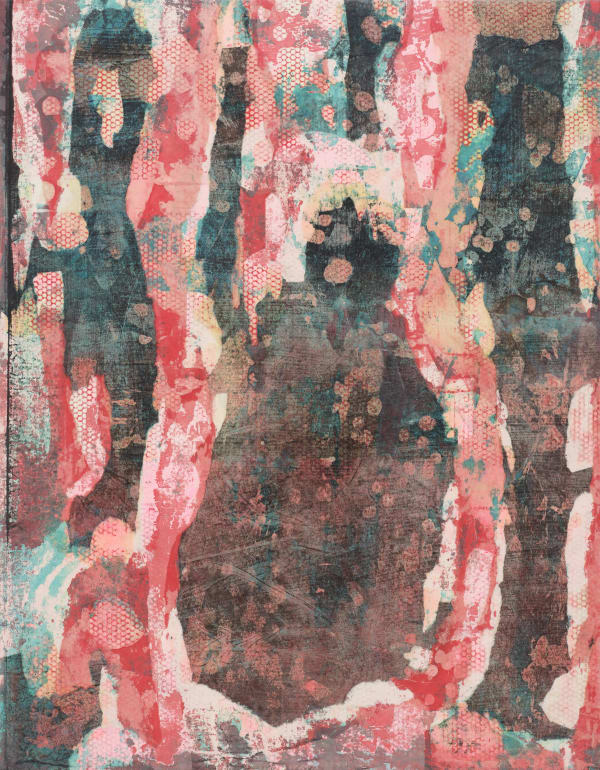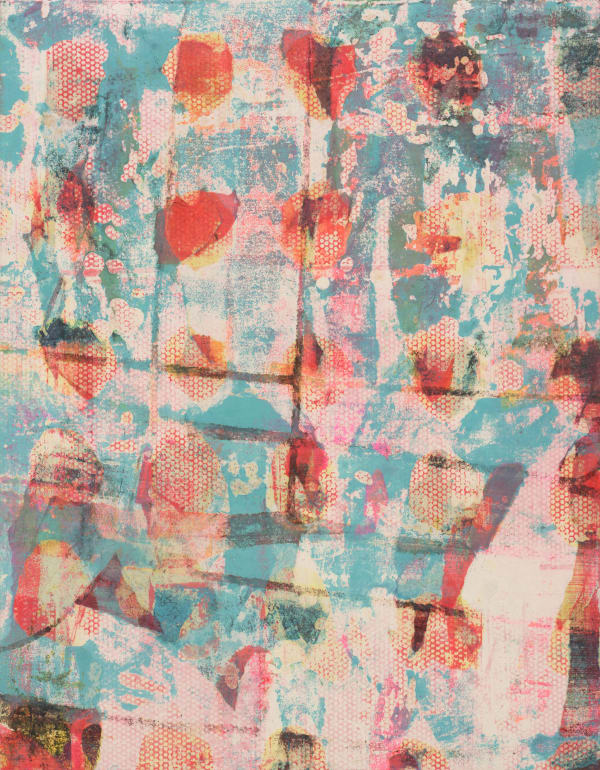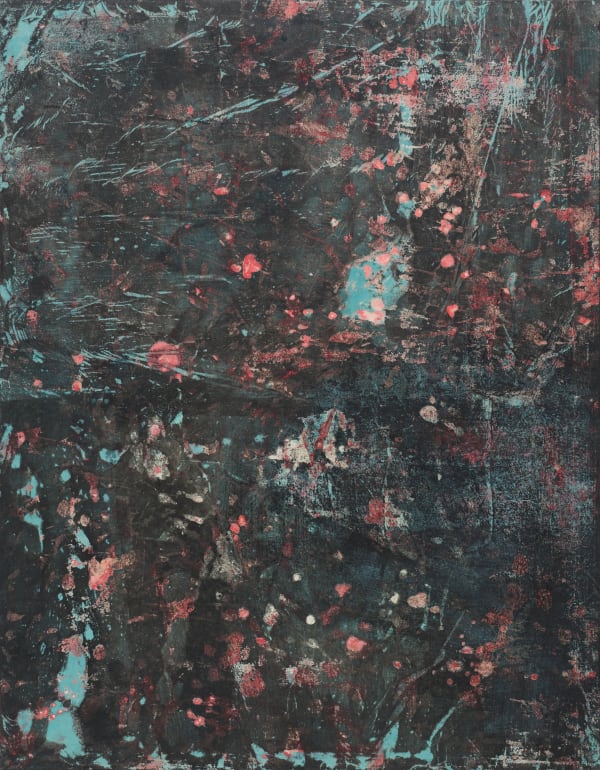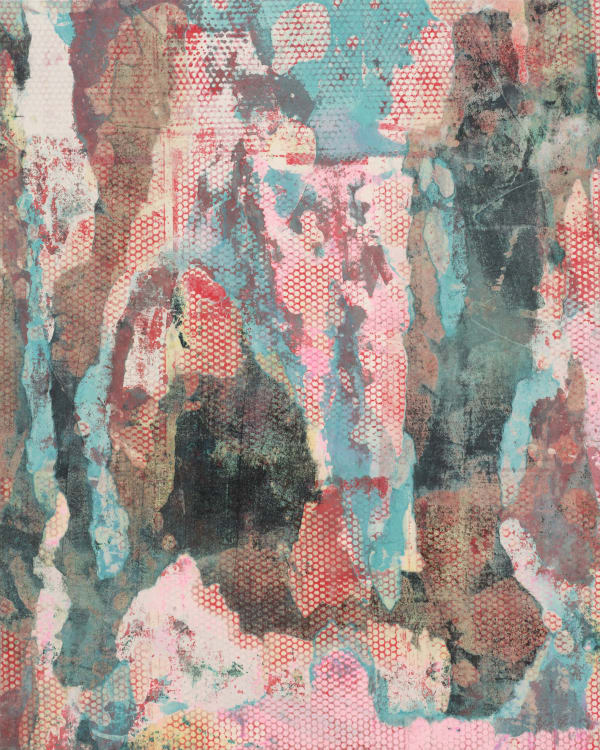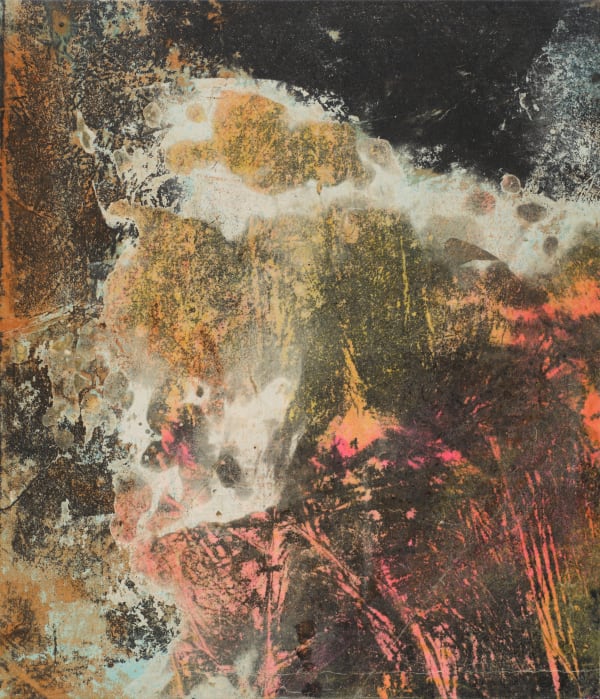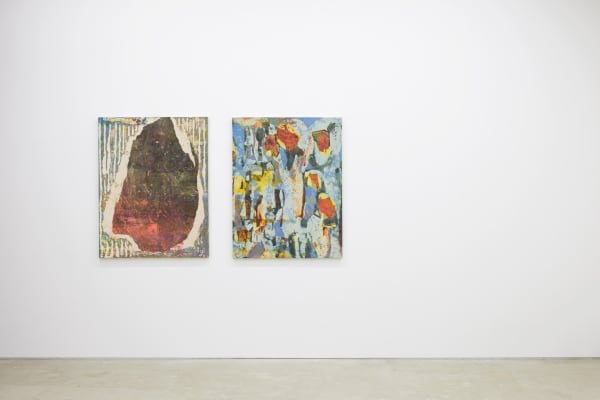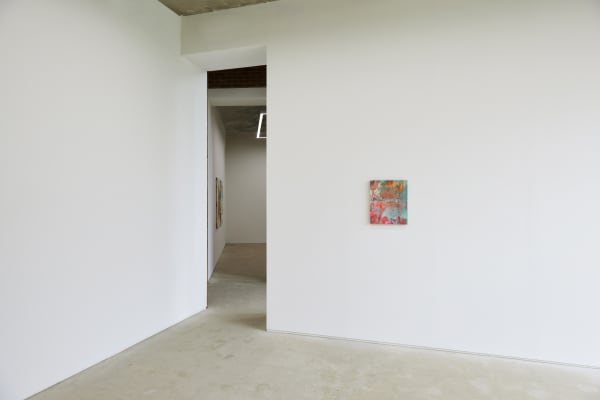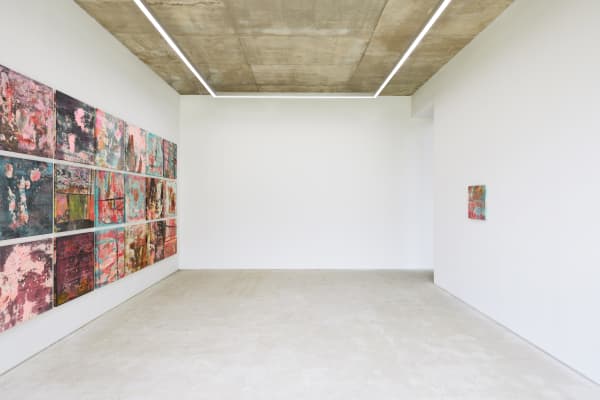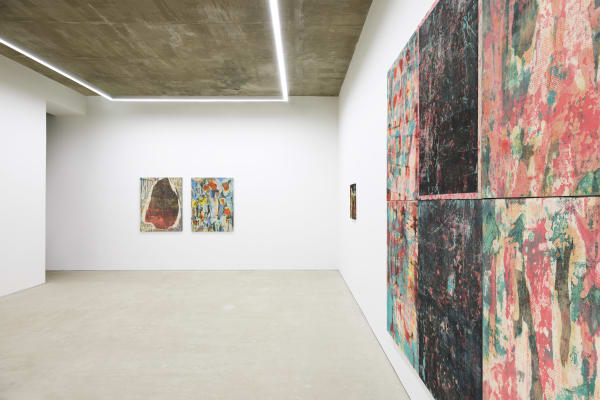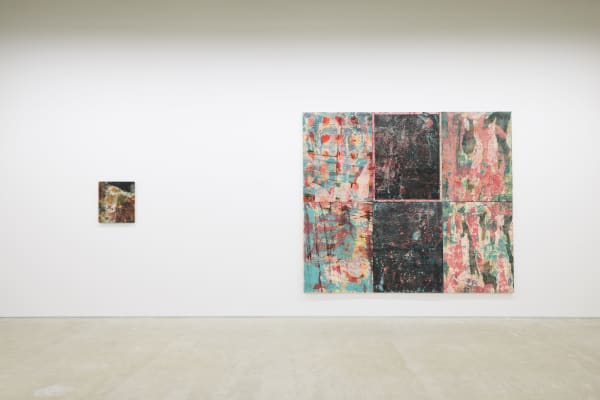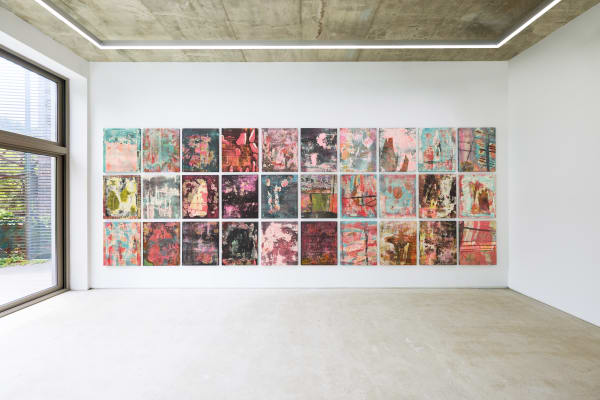매미 날개 Cicada Wings: 이소정 Sojung Lee
이소정의 회화는 무언가를 그리는 것이 아닌 어떻게 만들어지는 것인가라는 질문에 집중한 결과물이다. ‘그린다’는 것은 화면 위에 물감을 입혀가며 ‘형상’을 만들어 내는 과정이다. 하지만 작가는 재료의 물성과 재료 간에 일어나는 현상을 활용하여 ‘효과’를 만들고, 그 행위에 의해 드러나는 결과를 보여준다. 그가 자신의 작업을 ‘만든다’고 표현하는 이유는 여기에 있다.
이전의 연작들에서는, 그림을 제작하는 매뉴얼을 만드는 것이 작업의 시작이었다. 과연 어느 순간 ‘붓을 놓아야 하는지’, 완성의 지점이라는 것에 대해 의문을 가진 작가는 매뉴얼을 만들고 그 규칙에 따라 필연적으로 완성의 지점에 도달하는 방법론을 마련했다. 매뉴얼을 잘 따르면 조립식 가구가 근사하게 완성되는 것처럼. 그러나 작가는 오히려 그 통제의 과정에서 만나게 되는 우연한 균열과 변칙의 순간에 통쾌함을 느꼈고 그 역설을 작업의 주제로 삼았다.
2019년 작가는 여태까지는 통제의 대상이었던 우연한 ‘효과’의 자율적인 모습 속에서 아름다움을 느끼게 된다. 그리고 그는 그림의 완벽한 귀결점을 규정하기보다는 우연적인 효과를 통해 형상의 힌트를 얻고 예상하지 못한 완성 지점을 ‘찾아’가는데 집중한다. 이러한 과정이 가능한 것은 화면 위에서 다양한 물성을 실험하기 때문이다. 그는 물감과 물감, 먹과 물감, 종이와 안료, 그리고 밀랍 등 지지체 위에서 여러 물성을 의도적으로 부딪히게 하면서 우연적인 효과를 만들어 낸다. 의도한 것들과 예상하지 못한 것들이 한 화면 위에서 충돌과 극적 화합을 반복한다.
새로운 연작에는 기존의 제작 방식과 더불어, 작가가 ‘탈각(脫殼’) 혹은 ‘박피(剝皮)’라고 표현하는 새로운 과정이 더해졌다. 이는 쉽게 말해 종이를 벗겨내는 과정을 말한다. 작가가 지지체로 삼는 ‘3합 장지(壯紙)’는 한국화에서 주로 채색화에 사용되는 두꺼운 종이로, 3장의 얇은 종이를 겹쳐 붙인 것이다. 3겹의 종이는, 색과 먹을 머금으면서 각 층이 서로 다른 농도를 지니게 되고, 종이를 벗겨내는 방식을 통해 종이에 침투한 각 층을 찾아 나가게 된다. 손으로 뜯거나 칼로 오려내는 등의 방식으로 벗겨낸 부분은 형상이 되기도 하고 배경이 되기도 한다. 또한 보는 사람에 따라 형상과 배경은 전환될 수도 있다.
종이의 층을 벗겨내는 것뿐만 아니라 색과 색이 부딪히면서 발생하는 효과도 중요한 부분이다. 작가는 종이를 한 겹씩 벗겨내는 과정과 더불어 각 층에 다른 색의 물감을 칠하는데, 이에 따라 층마다 다른 농도와 층위의 색과 효과를 만든다. 작가는 종이를 한 겹씩 벗겨내고, 색을 칠하고, 다시 벗겨내고, 밀랍을 사용하여 보전하고 싶은 부분을 봉인하는 과정을 반복한다. 또한, 마지막 순간 종이를 뒤집어 뒷면이 그림이 되기도 한다. 이렇게 이질적인 요소들이 만나 강렬한 대비를 만들고 이를 화면에 자연스럽게 녹여내는 것이 작가의 일이다.
작가는 자신이 하고 있는 일련의 행위가 마치 전각을 하는 것과 같다는 생각을 했다. 그리고 부친으로부터 전각과 탁본을 배우며 들었던 ‘매미 날개처럼 하라’라는 표현을 기억해 냈다. 매미 날개는 견고한 구조와 기능을 가지면서도 조형미까지 가지고 있다. 즉, 돌 혹은 나무 표면의 물성을 입체적으로 파악하며 깎아 나가면서 동시에 그것이 종이에 찍혀 나온 평면으로서의 조형미 역시 가늠하며 균형감을 가져야 한다는 뜻이다.
이소정의 작업은 우연성과 필연성, 색과 색, 재료와 재료, 종이의 앞면과 뒷면 등 경계에 대한 탐구와 해체로 귀결된다. 이는 서로 다름을 이야기하는 것이 아니다. 서로 다른 두 요소를 의도적으로 부딪히게 하면서도 그 결과는 자연스럽게 받아들이는 것이 그의 작업이다. 규정된 기법이나 손의 기술만을 따라가면 구조적으로 완벽할 수 있지만, 조형적인 아름다움에서 벗어날 수 있다. 그러나 아름다운 그림이 꼭 좋은 그림은 아니다. 작가의 목표는 그 구조와 조형미가 이루는 조화와 균형감이다. 구조적으로 완벽에 가까우면서도 조형적으로도 아름다운 매미 날개처럼 말이다.
Sojung Lee approaches the hanji (韓紙: mulberry paper) canvas with the question of "how will it be made" rather than "what to paint," and the resulting painting reflects her concern. Her process of creating an image is adding paint to space and creating forms. She utilizes the manifested phenomena of the materials' physical properties and their interactions to generate effects, which she guides towards their conclusive outcome on hanji. This elaborate process is why Lee describes her practice as creating, rather than merely painting.
In Sojung Lee's previous serialized works, she followed a step-by-step manual for creating a painting. This reference guide was based on her investigation of what constitutes a completed painting, where she could relinquish control of the brush. To define such completion, she developed an instruction manual that defined steps culminating in a final stage. It was akin to modular, prefabricated furniture that merely required adherence to the steps of a pictorial instruction manual. Paradoxically, it was within this rigid control that the artist encountered exceptions, unexpected cracks, and anomalies, which she found elating. The exceptions to these established rules became the subject of her painterly practice.
In 2019, Lee found beauty in the free-form results arising from a chance effect that she had been attempting to control. Rather than determining a final conclusive moment for the painting, she focused on seeking hints about chance shapes that could lead to an unforeseen point of completion. This probing process was made possible through her experimentation with different materialities on the hanji canvas. She deliberately introduced coincidental effects by colliding various physical properties of substrates, such as paint with paint, Indian ink with paint, paper with pigment, and even beeswax. The intended and the unexpected meet on the canvas, creating a dramatic interplay of collision and harmony.
In addition to the artist's established method, the new series incorporates a process she describes as exuviating (脫殼), or flaying (剝皮). The artist peels off layers of hanji paper, to put it simply. The samhap jangji (將紙: cardstock mulberry paper), which she uses as a substrate, consists of samhap (triple-ply) of hanji predominantly used in Korean colored paintings. Each layer absorbs colors and ink to varying degrees of shade and intensity. The final form of the artwork emerges as the layers are peeled off, leaving areas that represent forms or backgrounds, which, depending on the viewer, may appear reversed.
As important to the creation of the works as the delayering process is the interplay of colors that follows. Colors are added in a manner that distinguishes the strata with varying shades and intensity. As layers are removed and colors are added, Lee also uses wax to laminate and seal what she deems complete and worth preserving. In some cases, the reverse side of the hanji canvas becomes the completed painting. Overall, the artist's creative process explores strong contrasts and harmonization between disparate elements on the canvas.
Sojung Lee discovered many parallels between her creative process and the craft of jeongak (篆刻: seal-cutting), drawing connections with childhood memories of her father teaching her seal-cutting and ink-rubbing takbon techniques. She describes the desired end result as cicada wings. Cicada wings are characterized not only by their solid structure, serving a specific function, but also by their sculptural aesthetics pleasing to the eye. In the context of seal-cutting and takbon printing, the concept of cicada wings translates into solid aesthetic structures that serve the function and form of two-dimensional prints while harmonizing with the stone or wooden materiality from which they are carved.
Sojung Lee's works explore and deconstruct the boundaries between contingency and inevitability, colors, materials, and even the front and back of paper. The objective is not to demarcate their differences, but rather to allow encounters between differences and accept the outcomes matter-of-factly. Prescribed techniques and manipulations give way to structural perfection but often lose the sense of sculptural beauty. She seeks a balance between structure and aesthetics, much like cicada wings that embody both structural perfection and sculptural beauty.
